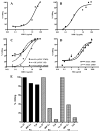Ocular surface expression and in vitro activity of antimicrobial peptides
- PMID: 17852183
- PMCID: PMC2430515
- DOI: 10.1080/02713680701446653
Ocular surface expression and in vitro activity of antimicrobial peptides
Abstract
Purpose: Human ocular surface epithelia express four antimicrobial peptides (APs): beta -defensin (hBD) 1-3 and LL-37. Here the expression of additional APs (hBD 4-6, HE2beta 1; histatin-1, -3; liver expressed antimicrobial peptide-1, -2; macrophage inflammatory protein (MIP)-3alpha, and thymosin (T)beta -4) was sought and activity against common ocular pathogens studied.
Methods: AP expression was determined in human corneal and conjunctival epithelial cells (HCEC, HCjEC) by RT-PCR and in corneal sections by immunostaining. Antimicrobial assays were performed to assess peptide (hBD 1-3, LL-37, MIP-3alpha, and Tbeta 4) activity against Pseudomonas aeruginosa (PA), Staphylococcus aureus (SA), and Staphylococcus epidermidis (SE) in the presence of NaCl or tears.
Results: HCEC and HCjEC expressed MIP-3alpha and Tbeta 4. hBD 1-3, MIP-3alpha, and Tbeta 4 showed activity against PA. hBD-3 had potent activity against SA and SE, whereas hBD-2, MIP-3alpha and Tbeta 4 had moderate activity and hBD-1 had none. NaCl markedly attenuated, and tears almost completely inhibited the activity of hBD 1-2 and Tbeta 4, but not that of hBD-3.
Conclusions: The ocular surface epithelia additionally express MIP-3alpha and Tbeta 4 which have moderate antimicrobial activity. The current data support a role for hBD-3 as an antimicrobial peptide in vivo, but call in to question the effectiveness of some other APs. However, further study is required to conclusively elucidate the physiological role of each AP.
Figures





References
-
- Sack RA, Nunes I, Beaton A, et al. Host-defense mechanism of the ocular surfaces. Biosci Rep. 2001;21:463–480. - PubMed
-
- Patrzykat A, Douglas SE. Antimicrobial peptides: cooperative approaches to protection. Protein Pept Lett. 2005;12:19–25. - PubMed
-
- Beisswenger C, Bals R. Functions of antimicrobial peptides in host defense and immunity. Curr Protein Pept Sci. 2005;6:255–264. - PubMed
-
- McClellan KA. Mucosal defense of the outer eye. Surv Ophthalmol. 1997;42:233–246. - PubMed
Publication types
MeSH terms
Substances
Grants and funding
LinkOut - more resources
Full Text Sources
Other Literature Sources
Miscellaneous
